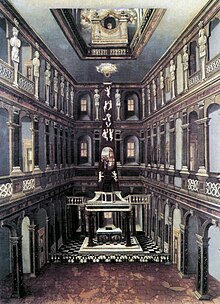Mein Gott, wie lang, ach lange? BWV 155

Mein Gott, wie lang, ach lange (My God, how long, ah, how long), BWV 155, is a church cantata by Johann Sebastian Bach. He first performed it in Weimar on the Second Sunday after Epiphany, on 19 January 1716.
History and words
In Weimar, Bach was the Konzertmeister of Johann Ernst von Sachsen-Weimar. It was part of his duty to perform a monthly church cantata. He wrote this cantata for the Second Sunday after Epiphany and first performed it on 19 January 1716 in the Schlosskirche (ducal chapel).
The prescribed readings for the Sunday are Romans 12Template:Bibleverse with invalid book:6–16 and John 2Template:Bibleverse with invalid book:1-11, the Marriage at Cana. The cantata text was written by the court poet Salomon Franck and published in 1715 in Evangelisches Andachts-Opffer. He expanded one thought from the gospel: Jesus is still hidden, but the "soul" may trust that he will appear at the right time. The poet uses images of wine to allude to the miracle at the marriage, such as "Der Tränen Maß wird stets voll eingeschenket, der Freuden Wein gebricht" (that the measure of tears is always fully granted, the wine of joy is lacking). The closing chorale is stanza 12 of Paul Speratus' Es ist das Heil uns kommen her.[1]
Bach performed the cantata again in a revised version in his first year in Leipzig on 16 January 1724.[2]
Scoring and structure
Similarly to other Weimar cantatas, the work is intimately scored for soprano, alto, tenor and bass soloists, a four-part choir for the chorale only if at all, an obbligato bassoon, two violins, viola, and basso continuo.[1]
- Recitativo (soprano, strings): Mein Gott, wie lang, ach lange
- Aria (alto, tenor, bassoon): Du mußt glauben, du mußt hoffen
- Recitativo (bass): So sei, o Seele, sei zufrieden
- Aria (soprano): Wirf, mein Herze, wirf dich noch
- Chorale: Ob sich's anließ, als wollt er nicht
Music
The opening recitative, speaking of longing waiting, expands expressively on a throbbing pedal point of 11 measures, moving only on the words "der Freuden Wein gebricht" mentioning "joy" (the lack of joy, though), only to sink back for the final "Mir sinkt fast alle Zuversicht" (almost all my confidence has drained away). In the following duet, an unusual obbligato bassoon plays virtuoso figurations in a wide range of two and one half octaves (including a truly remarkable G0), whereas the voices sing together, for most of the time in homophony.[3] Movement 3 speaks words of consolation, Bach chose the bass as the Vox Christi (voice of Christ) to deliver them, almost as an arioso on the words "Damit sein Gnadenlicht dir desto lieblicher erscheine" (so that the light of His grace might shine on you all the more brightly). In the final aria, lively dotted rhythms in the strings and later in the voice illustrate "Wirf, mein Herze, wirf dich noch in des Höchsten Liebesarme" (Throw yourself, my heart, only throw yourself into the loving arms of the Highest), the rhythms even appear in the continuo several times, while the strings rest on long chords. The tune of an Easter chorale from the 15th century closes the cantata in a four-part setting.[1]
Recordings
- Die Bach Kantate Vol. 22, Helmuth Rilling, Gächinger Kantorei, Bach-Collegium Stuttgart, Ingeborg Reichelt, Norma Lerer, Friedrich Melzer, Hanns-Friedrich Kunz, Hänssler 1971
- J.S. Bach: Das Kantatenwerk - Sacred Cantatas Vol. 8, Nikolaus Harnoncourt, Tölzer Knabenchor, Concentus Musicus Wien, soprano soloist of the Tölzer Knabenchor, Paul Esswood, Kurt Equiluz, Thomas Hampson, Teldec 1985
- J.S. Bach: Complete Cantatas Vol. 3, Ton Koopman, Amsterdam Baroque Orchestra & Choir, Caroline Stam, Elisabeth von Magnus, Paul Agnew, Klaus Mertens, Antoine Marchand 1995
- J.S. Bach: Cantatas Vol. 5, Masaaki Suzuki, Bach Collegium Japan, Midori Suzuki, Yoshikazu Mera, Makoto Sakurada, Peter Kooy, BIS 1997
- Bach Cantatas Vol. 19: New York, John Eliot Gardiner, Monteverdi Choir, English Baroque Soloists, Joanne Lunn, Richard Wyn Roberts, Julian Podger, Gerald Finley, Soli Deo Gloria 2000
References
- ^ a b c Alfred Dürr. 1971. "Die Kantaten von Johann Sebastian Bach", Bärenreiter (in German)
- ^ John Eliot Gardiner (2006). "Cantatas for the Second Sunday after Epiphany / Old Royal Naval College Chapel, Greenwich" (PDF). solideogloria.co.uk. Retrieved 10 December 2010.
- ^ Julian Mincham (2010). "Chapter 37 BWV 155 Mein Gott, wie lang, ach lange". jsbachcantatas.com. Retrieved 10 January 2011.
External links
- Free scores by Cantatas, BWV 151–160 at the International Music Score Library Project (IMSLP)
- Cantata BWV 155 Mein Gott, wie lang, ach lange on bach-cantatas.com
- German text and English translation, Emmanuel Music
- Mein Gott, wie lang, ach lange on the Bach website (in German)
- BWV 155 Mein Gott, wie lang, ach lange on uvm.edu
- Entries for BWV 155 on WorldCat
